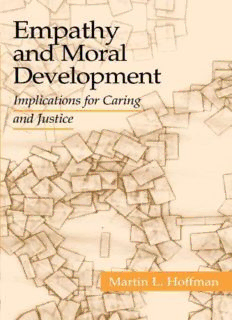
Empathy and Moral Development: Implications for Caring and Justice PDF
Preview Empathy and Moral Development: Implications for Caring and Justice
Empathy and Moral Development Implications for Caring and Justice Contemporary theories have generally focused on the behavioral, cognitive, or emotional dimensions of prosocial moral development. In this volume, Martin L. Hoffman brings these three dimensions to- gether while providing the first comprehensive account of prosocial moral development in children. The main concept is empathy - one feels what is appropriate for another person's situation, not one's own. Hoffman discusses empathy's role in five moral situations: one harms someone, one is an innocent bystander, one blames oneself though innocent, one must choose which among several victims to help, or one is torn between contradictory caring and justice concerns. The book's focus is empathy's contribution to altruism and compassion for others in physical, psychological, or economic distress; to feelings of guilt over harming someone; to feelings of anger at others who do harm; and to feelings of injustice when others do not receive their due. Also highlighted are the psychological processes involved in em- pathy's interaction with certain parental behaviors that foster moral internalization in children and the psychological processes involved in empathy's relation to abstract moral principles such as caring and distributive justice. This important book is the culmination of three decades of study and research by a leading figure in the area of child and developmental psychology. Martin L. Hoffman is Professor of Psychology at New York Univer- sity. He is series editor for Cambridge Studies in Social and Emotional Development. Empathy and Moral Development IMPLICATIONS FOR CARING AND JUSTICE Martin L. Hoffman New York University CAMBRIDGE UNIVERSITY PRESS CAMBRIDGE UNIVERSITY PRESS Cambridge, New York, Melbourne, Madrid, Cape Town, Singapore, Sao Paulo, Delhi, Dubai, Tokyo, Mexico City Cambridge University Press 32 Avenue of the Americas, New York, NY 10013-2473, USA www. Cambridge. org Information on this title: www.cambridge.org/9780521012973 © Cambridge University Press 2000 This publication is in copyright. Subject to statutory exception and to the provisions of relevant collective licensing agreements, no reproduction of any part may take place without the written permission of Cambridge University Press. First published 2000 First paperback edition 2001 Reprinted 2003, 2007 (twice) A catalog record for this publication is available from the British Library ISBN 978-0-521-58034-2 Hardback ISBN 978-0-521-01297-3 Paperback Cambridge University Press has no responsibility for the persistence or accuracy of URLs for external or third-party Internet Web sites referred to in this publication, and does not guarantee that any content on such Web sites is, or will remain, accurate or appropriate. Information regarding prices, travel timetables, and other factual information given in this work are correct at the time of first printing but Cambridge University Press does not guarantee the accuracy of such information thereafter. This book is dedicated with love to my wife, Ann, my children, Amy and Jill, and my grandchildren, Alison, Nicole, and Sarah Contents Acknowledgments page ix 1 Introduction and Overview 1 Part I Innocent Bystander 2 Empathy, Its Arousal, and Prosocial Functioning 29 3 Development of Empathic Distress 63 4 Empathic Anger, Sympathy, Guilt, Feeling of Injustice 93 Part II Transgression 5 Guilt and Moral Internalization 113 6 From Discipline to Internalization 140 Part III Virtual Transgression 7 Relationship Guilt and Other Virtual Guilts 175 Part IV Is Empathy Enough? 8 Empathy's Limitations: Over-Arousal and Bias 197 Part V Empathy and Moral Principles 9 Interaction and Bonding of Empathy and Moral Principles 221 10 Development of Empathy-Based Justice Principles 250 vii Contents 11 Multiple-Claimant and Caring-Versus-Justice Dilemmas 263 Part VI Culture 12 The Universality and Culture Issue 273 Part VII Intervention 13 Implications for Socialization and Moral Education 287 References 299 Author Index 319 Subject Index 325 viii Acknowledgments This book owes much to many. If my discipline and internal- ization theory works, it was Amy and Jill's challenges that taught me, for instance, that power assertion can be necessary for the voice of induction to be heard. I used to think it was good for children to have developmental psychologist parents, but in fact I learned more from them than they benefited from my "using" psy- chology. My graduate students were important. I remember talking to one in Ann Arbor about how different it must be to empathize with someone in distress before, and after, one has a sense of oneself as distinct from others. That discussion led me eventually to hypothe- size that self-other differentiation transforms children's global em- pathic distress in part into sympathetic distress. In a seminar I sug- gested that inductions contribute to internalization because they have meaning, which makes their content more memorable than background factors such as the source of inductions being the par- ents. An alert student said this reminded him of the "sleeper effect" in persuasion research when the salience of the message is greater than that of its source; another said it fits with Tulving's semantic- episodic memory distinction. These comments made me think, hey, my suggestion is plausible, so I'll stay with it. Undergraduates helped, too, especially those in my 1997 class to whom I taught the book's first draft. Their questions revealed gaps in my theories, their anecdotes enlivened some of my concepts such as empathic anger and relationship guilt, and their writing-style IX
Description: